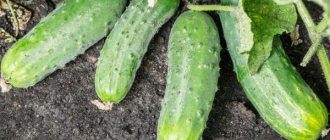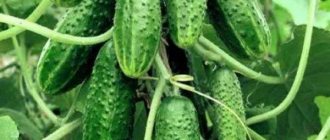Eggplant Epic F1 is a desirable hybrid in every area. This eggplant is suitable for cultivation in open beds and temporary shelters. The fruits have excellent taste and marketability. The harvest is perfectly preserved in cool conditions for up to 1 month and can be used universally: for processing, home cooking, and mass market sales.
| Origin | Landing location | Ripening period | Fruit color | Fruit weight | Fruit shape |
| Hybrid | Greenhouse | Early ripening | Violet | 210-280 g. | Cylindrical |
Description and characteristics of the variety
Epic F1 is part of the group of early eggplants. From germination to full technical maturity of the fruit, on average it takes up to 98-105 days. The harvest is harvested once a week, starting in mid-July.
Cultivation is carried out in the Central region in open beds. In the conditions of the Urals, temporary covering structures are used. In Siberia, the hybrid is grown in greenhouses (if necessary, heated during frost periods).
The hybrid variety is characterized by a semi-standard growth type. The length of the shoots reaches 1 m. The crown is spreading and needs garter. There is pubescence of the trunks. There are no spines near the flower cups, which makes cleaning and preparation easier.
Among the main features of vegetables:
- diameter 8-10 cm;
- surface glossy purple;
- creamy flesh;
- few seeds;
- length reaches 21-22 cm;
- average weight 210-280 g.
The fruits have a piquant taste in various dishes - caviar, baked side dishes, cutlets, appetizers. The pulp is nutritious and rich in B vitamins and ascorbic acid. It also contains a lot of microelements - magnesium, iron, calcium and potassium. Nutritionists advise introducing eggplants into the diet of people with diseased blood vessels and hearts, and with reduced motor function of the gastrointestinal tract.
For which region is Epic eggplant zoned?
Epic F1 entered variety testing in Russia in 2005 at the request of the Dutch company Monsanto. The hybrid successfully passed them and in 2008 was entered into the State Register of Breeding Achievements with permission for cultivation in all regions of the Russian Federation. But in the description from the State Register there is a contradictory phrase.
Included in the State Register of the Russian Federation for cultivation in open ground in private household plots in the southern regions of the country.
FSBI "State Varietation Commission"
https://reestr.gossort.com/reestr/sort/9463882
In what region is this hybrid grown? Perhaps it can be planted in open ground only in the south, and in other regions - in a greenhouse. After all, eggplants are a heat-loving crop. In cool conditions, the fruiting period is delayed, which means that fewer fruits will have time to grow, and the yield will be low.
Video: Epic in open ground in southern Siberia
Landing
Seed material must be disinfected before planting. To do this, you can use a 0.5% soda solution (0.5 g per 1 powder per 100 ml), 1% Fitosporin (0.5 tsp per 100 ml). The land is made up of garden turf. Rotted humus, compost, and old sawdust are added to increase fertility. To improve drainage properties and looseness, add 1-1.5 parts of fine-grained sand.
The planting period begins in February and ends in March.
How to disinfect soil:
- Heat in the oven for 20 minutes;
- pour boiling water over it;
- heat in a microwave oven for 2-3 minutes (optimal power 800-850).
Seeds for seedlings are planted to a depth of 1.6-1.9 cm, they are laid out in holes or grooves. Maintain a distance of up to 5 cm in containers between rows. Before germination, place the containers in a warm place (25-27 degrees) and cover with film.
Key points in caring for seedlings:
- irrigation with a syringe or spray bottle with settled water (temperature not lower than 22-23 degrees);
- picking at the stage of appearance of 2 leaves;
- feeding with nutrient mixtures (Kemira, Fertika, Effect);
- watering with mullein solutions (dilution 1 to 15);
- turning on fluorescent lamps in cloudy weather and in the evenings.
Description of the variety from seed producers
In Russia, original seeds are sold under the Seminis brand, this brand belongs to Monsanto. On the seed packets you can see information that is not in the State Register, but is of interest to gardeners:
- The ripening period after planting 45-day-old seedlings is 60–64 days.
- Bush height - up to 90 cm.
- Fruit size is 10x20 cm.
- The shape of the fruit is oval, and judging by the picture and video review above, teardrop-shaped.
Epic F1 seeds are supplied to Russia, the picture shows that the shape of the fruit is teardrop-shaped
Seminis claims that the hybrid is stress-resistant; on some seed packets you can read about high fruit set and even see the “Tested by Siberia” marking. The video (Moscow) also talks about resistance to bad weather. Epic grew in open ground. The same video talks about the cold summer of 2021, which affected the early fruiting of the hybrid; the fruits began to ripen only in September, despite the early ripening period. What kind of stress resistance and good communication are we talking about then? The lack of harvest in some years is evidenced by a review from a gardener, which I found under that video.
To my great regret, this year the Epic eggplant did not give me any harvest! 5 bushes were planted on June 10 in open ground under nutrosil and they sat silently until the end of July; in August they suddenly bloomed and produced several small fruits!!!! Although other varieties King of the North, Marquis, Giselle and Esaul fruited normally for this summer. The conditions were the same for everyone.
Irina Bu
https://www.youtube. com/watch?v=1bOrSGVN-AU
Growing and care
The bushes begin to be watered a week after planting in a permanent place. Maintain a moisture regime - in hot weather, water up to 3 times a week, in high humidity, take breaks of up to 5-7 days, and monitor the moisture of the soil. Checks are carried out at a depth of 10-12 cm.
The greenhouse should be ventilated through the upper transoms and maintain an optimal humidity level of 62-70%. Overmoistening is dangerous due to the appearance of rot and sclerotinia.
For fertilizing in the first 2 weeks after transplantation, use urea, saltpeter, and nitroammophoska. With the appearance of buds, potassium salt (chloride or sulfate), superphosphate, and foscamide are added to nitrogen preparations.
During the active fruiting phase, phosphorus-potassium agents are added (40 g are diluted in 10 liters). 1 liter of mineral solution is poured under 1 bush.
Formation is carried out in 3 trunks in greenhouses. Up to 6 trunks are left in open beds. Pinch the stepsons and shoots up to the 1st fork. Trunks and heavy brushes are fixed.
Advantages and disadvantages
Hybrid Epic F1 is not in vain popular among gardeners. It has a lot of advantages, which made its seeds one of the most frequently purchased varieties for growing in garden plots. The advantages of the Epic hybrid are as follows:
- high levels of resistance to tobacco mosaic, which makes it possible to abandon the use of aggressive chemicals for plant protection;
- excellent yield;
- adapted to a wide range of growing conditions;
- good taste of fruits;
- the possibility of using eggplants for dietary nutrition;
- ease of care.
The disadvantages of this hybrid form include:
- the need to grow seedlings when cultivating on beds;
- impossibility of growing outdoors in cool climates;
- the bush needs tying up and shaping;
- fruits are not stored for a long time.
Eggplant is good for people suffering from cardiovascular diseases. Its pulp contains a large amount of potassium.
Growing eggplant seedlings of the Epic variety
You can easily grow seedlings from seeds by following simple rules. The seeds do not require any pre-treatment with drugs and do not need to be soaked before sowing.
Features of sowing seeds
An important factor influencing the success of growing seedlings is preparing the soil for planting and maintaining temperature conditions. It is better to choose mid-March for planting. From the moment of sowing to germination, as a rule, 15 days pass. Seedlings grow quickly and 2 weeks before transplanting require special hardening measures to prepare the plant for changing growing conditions.
The soil in which the seeds will be placed can be purchased or prepared independently from black soil, sand, peat and humus. Ash can be added to reduce acidity.
Growing eggplants in peat tablets
It is most convenient to sow seeds in separate cups, pots or peat tablets. This method will preserve the integrity of the root system during transplantation. They can also be sown in a box or greenhouse.
What is good about the Epic eggplant variety and why it is worth growing
“Little blue” eggplants, as many call them, are welcome guests on our table. In addition to the fact that they have a piquant taste, eggplants have many beneficial properties. They contain B vitamins, vitamin A, many minerals - potassium, phosphorus, calcium and others. In addition, it is useful for people with cardiovascular diseases, increases the contractility of the gastrointestinal tract (gastrointestinal tract), and has an anti-atherosclerotic effect.
Among the many different varieties, Epic is distinguished. Read about its features and cultivation rules in the article.
Reviews from gardeners
I planted eggplants in open ground under temporary cover made of spunbond. Hybrid Epic is very productive, without bitterness or seeds, and simply beautiful.
malinasoroka
https://dacha.wcb.ru/lofiversion/index.php?t39793–50.html
I want to praise Valentina, Solara, Epic. These are Dutch hybrids, approximately the same type. The flesh is tender. I grew up in the OG, without any shelter. It’s impossible to single out one of them, the very best - they’re all good.
Eleno4ka604
https://www.forumhouse.ru/threads/139745/page-7
Epic F1. The fruits are very large and do not last long. Plants are weaker than others and susceptible to viral diseases and spider mites.
Yulia Belopukhova, agronomist, candidate of biological sciences and summer resident
https://www.aif.ru/dacha/ogorod/baklazhany_narodu_kakoy_sort_vybrat
Epic eggplant is approved for cultivation in all regions, but is demanding on solar heat and light. It is better to grow seedlings without picking. To form large fruits, remove the shoots and normalize the harvest.
Pros and cons of the variety
Positive reviews from summer residents indicate that this variety is very favorable for cultivation. In addition to taste, it has a number of other advantages. Among them are:
- Plant resistance to tobacco mosaic virus and other diseases.
- High resistance to severe temperature changes.
- Its excellent taste allows it to be used as a dietary product. The variety contains a maximum of protein, potassium and vitamins with a minimum of fat.
- Easy care allows even beginners to grow this vegetable.
- Excellent yield, which can reach about 6 kg per 1 m².
This variety has a number of disadvantages, one of which relates to poor winter hardiness. Dutch agronomists have developed a hybrid that is mainly designed for cultivation in warm regions.
Summer residents living in the middle zone or the Far East have to grow it in greenhouse conditions. In addition, permanent garter also presents some difficulties when growing. If this variety is grown at home, it practically does not retain its freshness .
Collection and storage of fruits
Fruits are collected at the stage of technical maturity - every 2-3 days. Eggplants ripen approximately 3-4 weeks after the flowers appear.
Collection and storage of Epika fruits:
- Ripe eggplants have a dark purple color and firm flesh.
- The fruits must be cut with pruning shears.
- Unripe fruits are not picked - they do not ripen during storage.
- Fresh eggplants do not last long. To extend shelf life, wipe the fruits with a dry cloth and put them in a cool place. The storage temperature is maintained at +1 °C.
Tips for growing the Epic eggplant variety can be found in the following video:
Harvesting and use of crops - storage, use in cooking, preparations
Seedlings planted at the end of May will bear their first fruits in late July - early August. You will harvest in batches; the eggplants will ripen gradually. Storing fresh is problematic; the fruits will quickly deteriorate. It is better to cook fresh, or chop and freeze or dry.
Epic eggplants are used to make winter preparations - caviar, Peking-style eggplants, salted eggplants, spicy Korean-style fire. There are hundreds of recipes for canning and freezing.
The easiest way:
- Cut the eggplants and bake in the oven at 200 degrees.
- Remove the skin when ready and place the vegetables under a press to remove excess liquid.
- Place in bags and place in the freezer.
In cooking from Epic f1 they prepare marinated, baked, stewed eggplants stuffed with garlic and herbs, rolls with curd cheese and dill and a lot of other dishes.
You can also prepare a lot of delicious dishes from pumpkin; recipes are here.
Reviews from those who grew
Here are a few reviews from gardeners who grew the variety on their own plots.
Dmitry, Saratov: “Among the eggplants that I grew, the most delicious and unpretentious variety is Epic F1. Planted in a greenhouse and in the garden, the yield is excellent under any conditions. Fresh and young eggplants are good for frying in oil and grilling. Each bush produced 6-7 fruits. I always choose hybrids, they grow better and the yield is high.”
Anatoly, Novosibirsk: “A magnificent hybrid. The main thing is not to plant in the same place. I've been growing this for three years now. I scatter onion or garlic peels with straw on the eggplant bed. The husks repel pests, and the straw maintains the right moisture.”
To learn the best way to protect your garlic crop from pests, read this article.
Growing eggplants
Eggplants grow well in a greenhouse
In order for the seedlings to have time to form, the seeds are planted in mid-March in warm soil, preferably in a greenhouse.
Seed preparation
Before sowing, planting material must be disinfected. To do this, it should be placed for 20 minutes in a 2% solution of potassium permanganate. Then rinse the seeds in clean boiled water, dry and soak for a day in a growth stimulator. There is another way of disinfection - place the planting material for 10 minutes in a 3% solution of hydrogen peroxide, heated to a temperature of 40°C.
Three-year-old aloe juice, either pure or mixed in equal parts with water, is used as a growth stimulator. Place the seeds on a saucer, pour juice over them for a day, dry them and begin planting.
Planting seeds
As a primer, use a ready-made one or make your own substrate. The soil from the summer cottage is cleared of weeds and mixed in equal parts with sand and soil for indoor plants. You can also use peat mixed with sawdust and soil for seedlings.
Eggplants prefer loose, light soils enriched with minerals and organic compounds.
In tightly filled peat or plastic pots or any other container, moisten the substrate generously, sow the seeds and cover with a layer of soil no more than 1 cm. Wrap the container in transparent film and place in a warm place for germination.
Seedling care
Nightshade seedlings require careful care. The room temperature should not exceed 25°C. The first shoots will appear within 10 days. After this, remove the film and lower the temperature to 18°C. Within two weeks after germination, the temperature should be raised to 28°C during the day and lowered to 15°C at night. This will help harden the seedlings.
After some time, using a phytolamp, it is necessary to increase the daylight hours to 12 hours. The light source is installed at a distance of 50 cm.
The soil must be constantly moist. 3 days after sowing, the first watering is carried out, then every five days. If the soil is not enriched with minerals, then a week after germination it should be fed with phosphorus-containing fertilizer. Then, once every 7 days, apply fertilizer to increase green mass.
Planting seedlings in the ground
Formed strong seedlings 20 cm high should have at least 5 leaves. At the end of May, when the daytime temperature is above 15°, the eggplant seedlings are transplanted into open ground.
The soil should be slightly alkaline or neutral. Acid must be neutralized with limestone at the rate of 0.5 kg/m².
It is recommended to plant eggplants in areas where beans, peas, cabbage, garlic, onions, and herbs previously grew. Unfavorable predecessors are peppers, potatoes, tomatoes.
Each hole more than 10 cm deep is moistened with warm water and one sprout is planted. The distance between rows should be at least 65 cm, between bushes - 35 cm.
Watering
You need to water rarely, but a lot
Maintaining soil moisture is an important characteristic in growing seedlings. Watering should be done once a week, more often in hot weather. Excessive moisture will lead to rotting of the root system. Water the eggplants with settled warm water. During the period of active fruit growth, watering must be done daily.
After each moistening, the soil should be loosened for better access of oxygen to the roots. It is also recommended to mulch with straw mixed with onion and garlic peels. This helps retain moisture and reduce weed growth, and will also repel some pests.
Top dressing
The first feeding of plants is carried out two weeks after planting in the ground. To do this, use ammonium nitrate with superphosphate and potassium sulfate. It is also recommended to add 40 g of potassium-phosphorus fertilizer and 50 g of nitroammophosphate.
During the growing season, to increase the ovary, feed the soil with humus, compost, sawdust or rotted cow manure at the rate of 1 bucket per 1 m².
During fruit formation, a phosphate-nitrogen mixture is used - 1 tsp. Mix superphosphate and nitrate with 10 liters of water.
During the entire growing period, no more than 5 feedings should be made.
Harvesting
According to the description of the variety, the technical maturity of the fruits occurs 25 days after flowering, which means that in August Epic eggplants will be pleased with the first harvest. Harvesting is carried out every 3 days, as the product ripens gradually. It is recommended not to break off the stalk, but to cut it with pruning shears. This will reduce plant stress and ensure high-quality ripening of the remaining fruits.
It is important not to let the eggplant get too ripe. The pulp will lose its elasticity, become tough and too bitter.
Fruits of the Epic variety can be stored fresh for no more than three weeks. But there are several rules that will help preserve the fetus for 2-3 months:
- Wipe each eggplant dry;
- place vegetables in one layer in a cool room;
- Every three weeks, discard spoiled ones;
- Wrap the remaining fruits in paper, spread them on straw in one layer and cover with burlap.
Reviews from summer residents
The early ripening hybrid "Epic" is grown in household plots and garden plots quite often, which is due to the relative ease of cultivation and high yield, regardless of errors in care and the presence of external unfavorable factors. When grown in seedlings, the plants are strong, powerful and upright.
Many small farms grow Epik for further sale, since the attractive, good-tasting fruits are in great demand and have good consumer reviews: the fruits are large and glossy, the pulp has practically no seeds and is not bitter.
Seed preparation
Planting material needs disinfection. This procedure will avoid fungal diseases. You will need a 2% solution of potassium permanganate, 2 g diluted in 100 ml of water. Eggplant seeds are immersed in liquid and left for 20 minutes. After the procedure, they should be washed in cold boiled water and dried on a sheet of paper.
Hydrogen peroxide is also suitable for disinfection. After mixing 3 ml of the substance and 100 ml of water, the liquid is heated to 40 °C. As a rule, the manufacturer supplies the market with prepared products that do not require this procedure.
Transplanting seedlings into the ground and further care
As soon as there is no frost at night, you can start planting seedlings. This period, depending on the region and climatic conditions, begins in mid-May - early June. Seedlings should not be overgrown, as this may reduce their adaptive abilities.
Preparation for transplantation and hardening
Preparations for planting in open ground should begin no later than 2 weeks before planting. Compliance with the hardening rules is mandatory. Young eggplant bushes must adapt to the new conditions as much as possible. The condition for the procedure, which will ensure successful adaptation of the plant, is gradualism.
First, the seedlings are taken out onto the balcony or into the greenhouse for several hours. You can build a small greenhouse from arcs and film right in the garden. As a last resort, you can open the windows. The main thing is that there is no draft or frost. Gradually, the time the plants spend in a colder room should be increased. In the last 5 days they can be left overnight.
Transplantation into the ground
You may be interested in: Favorable days for planting eggplants in the Urals and Siberia in 2021. Dates for planting eggplants for seedlings in 2021 according to the lunar calendar of the gardener. Picking eggplants for seedlings according to the lunar calendar 2021
As soon as weather conditions are favorable, you can begin planting seedlings. When selecting a site, it is necessary to take into account the factors of illumination and fertility. If the soil is depleted, more frequent feeding with fertilizers will be a prerequisite. But it is better to fertilize the soil in advance.
You can choose a place where carrots, beans or peas previously grew, as well as in the place of melon plants. Planting is best done while maintaining a distance between bushes of 80x80 cm, since Epic grows to impressive sizes. You should take care of supports for bushes.
The prepared holes are generously filled with water. The seedlings are watered with plenty of water 2 hours before planting.
It is not necessary to deepen the bushes, since additional roots do not appear.
It should be remembered that airy, loose soil is more suitable for this crop. Therefore, you need to regularly remove weeds and loosen the soil.
Watering
After planting, watering does not occur for some time. Once the soil has dried, you can begin watering as usual.
The frequency depends on the ambient temperature. During the daytime, watering is strictly prohibited. This may harm the plant. It is best to do this in the evening and using water that has stood in the sun. The plant reacts very sharply to dry conditions. The fruits are poorly formed, and the leaves begin to turn yellow and dry out.
Fertilizers
Plants planted in the ground are fertilized 3 times. During planting, flowering and active ripening of fruits. At the first stage, fertilizer is produced from organic components.
Then the soil should be enriched with special mineral agents. If the soil is fertile enough and growth is active and there are no diseases, you can limit yourself to organic feeding.
How to grow this variety yourself
Both experienced gardeners and beginners can grow this variety on their own. To grow the Epic f1 eggplant variety, you will need to purchase seeds and fertilizers, grow seedlings, transplant them to the plot, harvest and enjoy your labors in various dishes. More details about each stage.
Since this is a hybrid, only purchased seeds are used; you cannot prepare them yourself from your own harvest. Seeds are sown in the first and second ten days of February.
Stage 1. Purchased seeds require preparation before planting: treat with a two percent solution of potassium permanganate and water at a ratio of 2 g per 100 ml. The seeds are dipped in a solution of potassium permanganate for 20 minutes. After the procedure, you need to rinse the seeds in running water and dry. It is better to dry on cotton material; the seeds will stick to the paper and if you try to remove them, you can destroy their structure.
Stage 2. Preparation of containers and soil for seedlings. Prepare individual cups, plastic containers with lids or boxes. Fill up the soil. You can mix part of the soil where the seedlings will move with sand and fertilize it with special seedling agents. Or use soil for seedlings from the store.
You can find out how to choose seeds for planting tomatoes here.
Stage 3. Planting seeds. It is necessary to moisten the soil with warm water, immerse the seeds to a depth of 1.5 cm at a distance of 2 cm from each other. No more than two seeds are planted in individual cups. After planting, cover with cellophane and place in a warm place (about 25 C°) in a well-lit place. When the sprouts appear, after 7-10 days, remove the film and place the seedlings in a cooler place (up to 16-18 C°) also with good lighting.
Stage 4. Fertilize the soil where the seedlings grow. Apply phosphorus fertilizer 10-15 days after germination. Then feed every 2 weeks until planting in the beds. This way you will speed up the growing season, and the seedlings will grow strong and strong.
Stage 5. Preparing for transplantation. When the seedlings reach a length of approximately 20 cm, about five leaves form on the trunk and the time of frost has passed, the seedlings are transplanted into beds or into a greenhouse.
Transfer
Divide your beds or areas in the greenhouse where you plan to transplant eggplant seedlings into 1 m² sections. Imagine that the presented field looks like a chessboard. It is necessary to plant 4-5 bushes on the “white” areas of the visual chessboard at a distance of 60-70 cm from each other.
Further care
Epic does not require special care. Like other plants in your garden, eggplants need to be watered regularly, inspected for pests, and fertilized promptly.
By following the simple rules presented below, you will reap a decent harvest:
- Water moderately and on time.
- Loosen the soil and prevent crust formation after watering.
- Weed, remove weeds.
- Fertilize regularly. Make the first feeding of the soil after the seedlings have become firmly established in the new territory. Fertilize with manure, compost, ash and mineral supplements. Fertilize a second time after the flowers appear - this time mainly with minerals. The third time - after the formation of the ovaries, fertilize with superphosphate or use the fertilizer complex “Nitrophoska” and “Ammofoska”.
- Be sure to tie up the bushes. If you don't do this, the stems may break and your expectations for the amount of harvest will not be met.
- If you remove too many stems, you can leave no more than eight.
Epic eggplants suffer from the same diseases as other eggplants. The variety is susceptible to late blight, gray rot and blackleg. Compliance with the principles of agricultural technology, as well as an annual change of where the crop is grown, will help avoid infection with these diseases. It would also be useful to treat with copper preparations, and for the prevention and treatment of late blight it is worth treating with Zircon.
To get acquainted with tomato diseases and find out how to deal with them, follow the link.
Common pests of this plant include:
- Colorado potato beetles - get rid of them by manually collecting insects; plant basil to repel them;
- slugs - they are also collected by hand; in case of a huge number, the ground is sprinkled with a mixture of lime, ash and tobacco dust;
- spider mites - get rid of them with the help of drugs “Strela” or “Keltan”, which are safe for humans.











